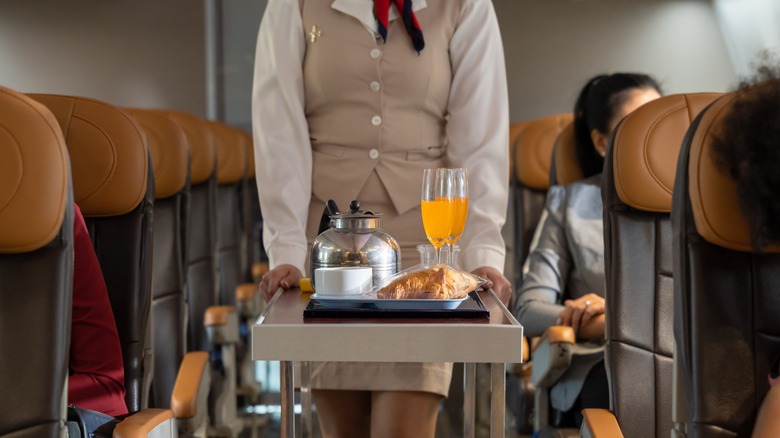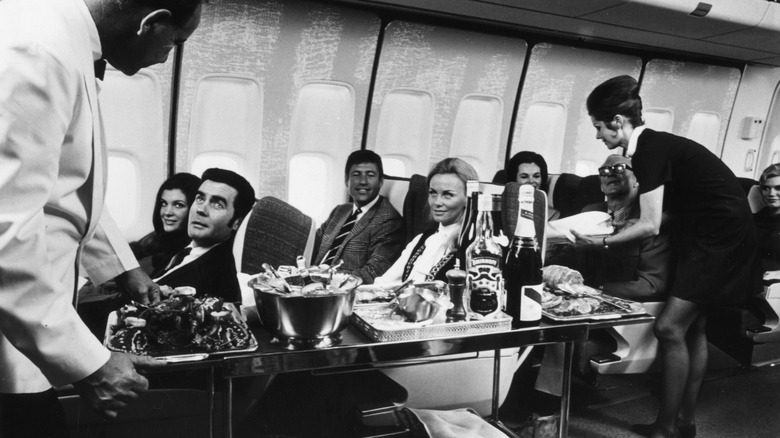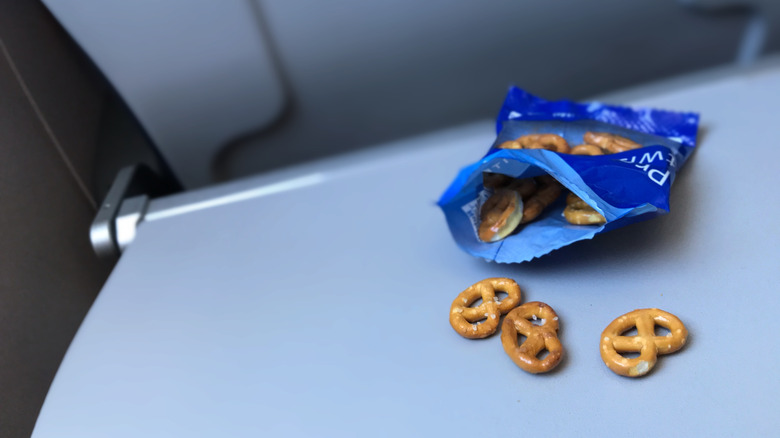The Fascinating History Of Airplane Food
If you know anything about airline food, it probably isn't good. In-flight cuisine has been the butt of so many jokes that it's become hacky. With such a negative reputation, there is little appeal to today's travelers, and airlines aren't doing themselves any favors. In-flight meals options have dwindled significantly in the 21st century to the point where most flights don't even offer them at all. It's a sad fall from grace for airline dining, which, as hard as it may be to believe, was once considered quite formal affairs.
The very first in-flight meal was served on October 11, 1919 to passengers on a Handley Page Transport flight from London to Paris. This was just as commercial airline travel was starting to take off (pun intended) in light of advances in aviation made during WWI. At that time, airplane engines were weaker and the craft couldn't carry much weight, so there was no chance of installing a kitchen space or systems for heating food. The first airline meal was a cold boxed lunch, and it cost passengers three shillings (around $10 in today's money).
Those early days of in-flight eating were tough. Airplanes of that era were so shaky that passengers had to eat off paper plates: ceramic plates and glassware would tumble around and shatter if the plane hit turbulence. Cold meals were the only option for over a decade before United Airlines made a move that changed everything.
The golden age of in-flight dining
In 1936, United Airlines installed the very first airplane kitchen. Finally, travelers could enjoy hot beverages and meals, although originally, United offered only two options: fried chicken and scrambled eggs. In the 1940s, airlines began producing frozen meals that could be reheated onboard planes. This development would go on to inspire the invention of TV dinners, and it ushered in a new era of air travel.
Aviation's golden age stretched from the 1950s to the 1960s, marking a time when flights were treated as glamorous events. Air travel was still mostly reserved for the wealthy, offering spacious cabins, comfortable seats, and cocktails. In-flight meals in the golden age were modeled on fine-dining restaurants. There were multiple courses, featuring meats carved seat-side from trolleys.
No airline emphasized luxury dining more than Pan Am. In the 1950s, they operated a fleet of seaplanes called "Clippers". These massive planes had dining rooms where passengers ate off china plates. Many of the menu offerings were inspired by French bistros, with dishes like Boeuf Bourgeois and Pommes Anna. There were also expansive cocktail menus. Meal services were intentionally elaborate in order to save passengers from boredom in the era before in-flight televisions and portable media players. Best of all, these meals were free, included with the price of each ticket. Dining service was a major selling point for airlines, but today, it's the opposite.
Why airplane food is on the decline
Airplane food has steeply declined since the golden age of flying, thanks to a few factors. For decades, the U.S. government mandated that every airline provide passengers with a meal included in the price of their ticket. That drastically changed in 1978 when the U.S. airline industry was deregulated, and the companies began calling their own shots. Complimentary meals became a thing of the past, since airlines can now earn extra money on food while avoiding the federal tax on ticket fares.
Like the rest of the aviation industry, in-flight dining was also forever changed by the September 11 attacks in 2001. In the aftermath, few people were willing to fly, and the airline industry cut costs wherever possible to make up for their financial losses. Most airlines outright eliminated their meal services, and more than two decades later, they haven't returned to their former selves. Today's airlines have little financial incentive to offer meals services, except to appeal to first class and business class travelers.
On top of all this, there's a fundamental issue with airplanes and food. The climate of a plane dulls your sense of taste, which is why first-class flyers are wasting good wine. A big part of the early appeal of airline food wasn't the food itself, but the idea that air travel was exciting and luxurious, an attitude that we've long lost. With reports emerging that airplane coffee might be unsanitary, amongst myriad other complaints, the public attitude towards airline food is now firmly in the negative.


